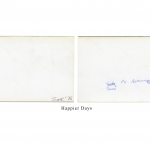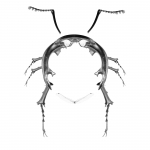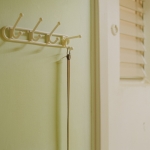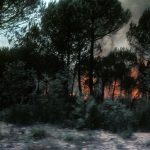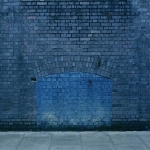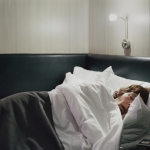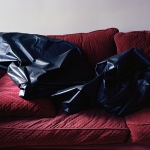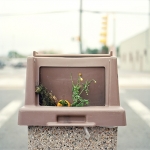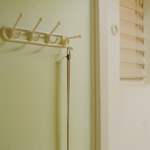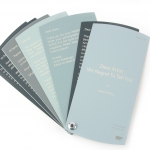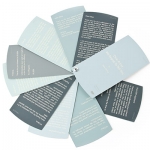Dana Stirling is a storyteller, and a damn good one at that. A visual narrator, Stirling unfolds past and present through anonymous people, objects and things, wrapping her own self expression in expressionless beauty and attacking her memories from an abstract vantage point. Rather than recount literally, she plays with the malleable demeanor of multimedia—collages, digital design, photography, books and overhauled finds—with the notion that nothing is permanent until it’s made personal.
Her work relates a collective interdependence between time and entity, but with an allure of imprecision, even false identity. It’s a mixed bag of subjective and definitive, where once-weres become plot tools in Stirling’s memories, recounted for the sake of the visual story and its enticing emotive details.
Still-photography series, rehabilitated images, passed-over submissions turned beautifully poetic (see Dear Artist We Regret To Tell You below)—it’s all part of Stirling’s story, remarkably documented in thoughtful, thought-evoking mediums, as can only be made brilliantly accessible by Stirling herself.
First off, who is Dana Stirling?
I was born 1989 in Jerusalem, Israel. My parents and Grandparents are from London, England. In England, my family had a strong connection to the Jewish community, yet after an anti-Semitic attack on my brother’s Hebrew school, my parents decided to move to Israel in 1988. I was the first to be born in Israel. After high school I joined the Israeli army (mandatory service) and served in the Youth & Education Corp. I was a Soldier-Teacher in a biblical national park, “Neot Kdumim,” near the city of Modi’in, teaching mainly children about the biblical stories through nature and the landscape. After my two years service, I started my BA in Photographic Communications at Hadassah College Jerusalem. I graduated in 2013 and right away I moved to NYC to join my partner Yoav Friedlander. I have been in NYC for two years now. I am currently an MFA student at the School of Visual Arts (photo, video and related media department) and will graduate in 2016.
What intrigues you about the still-life photography? Do you find that you’re telling the stories, or that it’s the job of the objects/places/people themselves?
I always felt more comfortable photographing objects. I think that through objects and still life I can say a lot about myself, and the people that are connected to the object. Still life has an interesting way of communicating different emotions just because we can reflect our own personal memories and stories on them and they can’t really fight back, whereas a photograph of a person is very much about the person and how we can or cannot relate to them.
Still life allows me to take my time, examine the object and the juxtaposition between it and its surrounding space in addition to the relation between me and that moment. That time allows me to fill the gaps with a narrative of my own. I realized as part of my process that more than the objects themselves telling a story, it is the act of photographing them and adding them into my context that is telling the real story I believe they should tell.
Do you find your subjects, or your subjects find you? What is your looking-through-the-lens process like?
I believe that I find the objects. When I travel or go to photograph I look for specific things, yet I don’t really know what I am looking for most of the time. I think any object could be relevant to me but not everything is. The object is a platform, similar to a medium, which I use to convey my feelings, history and memories. Therefore I need to feel the connection to that specific object for it to become a part of my narrative. I am very picky, and usually don’t shoot that much. Sometime I will pass on objects or scenes that might be what I am looking for, but I don’t feel 100% sure about them.
Your work reaches so many different levels, from your taxidermy to book production, to the lifeless objects you give so much creative integrity to. How do you balance that wide range, and what does your creative process look like with each new addition?
In the long run, all the projects deal in some way with the same notions. Even if sometimes the starting point is different, when I look back today at all the different projects I’ve made—they all have similar ideas and concepts. I think all of my work circles around the idea of reconstructing a reality of a possible past. Creating something new out of the old, out of the familiar and reclaiming it again in my new perspective and vision. In taxidermy, it was done as a final project in Photoshop class. I took images I’ve made of taxidermy bugs (4×5 film camera, BW film) and used Photoshop to create a new species of bugs. In my personal work I do the same, but with different aesthetics. Using old images from my own family album, and now more from found flea market imagery, I rebuild a narrative and identity that I feel represents me as an artist, and life in general under the perspective of photography. Each project had a different approach, if technically, aesthetically or conceptually. Some projects are more crafty—in the sense that I use my hands and physically manipulate images—such as “Its just paper” or my book. Some projects use digital manipulation and others use scanner manipulations (collaging). In all of them I usually create first out of instinct and from an intuition.
Your rejection book —Dear Artist We Regret To Tell You— is amazing, and welcoming some great reception. What pushed you to put it out there, and what has the reception been like?
I made this book in the beginning out of frustration, and mainly humor. I wanted to make something that I could look at and not only be inspired by it, but will make me happy. This book was not made out of anger towards those who rejected me, but more from a place of self-doubt and trying to reclaim my artistic passion.
After I made it, I sent it, as a reply to the original rejection letter (email), to all the places I used in my Book, wanting to share this with them, inform them and just to see their reaction. Some places never responded, but the places that did respond loved it and actually thanked me which was crazy in itself. FeatureShoot were the first to see the book’s potential and gave me the push I needed to promote the book. The reaction I got online from people was mostly really amazing. People have been contacting me to actually purchase it (something I wasn’t expecting), and in addition to say that the book inspired them to carry on, to submit to more places and felt that they are not alone in this situation.
Some bad comments I saw were mainly criticizing my young age. Many people felt that I was too young for this kind of project and that I should get more experience, and more rejections before I could make this book. I think rejection is for everyone. No one can own rejections. I’ve been told that you are always too young until you get too old. And I think that’s something very true in the art world. What people don’t know is that the book might “only” have 13 letters, but in fact I sent submissions to over 300 places in the last few years. Some never replied (which is a rejection in my eyes, but wasn’t useable in the book), but that the book doesn’t speak about a quantity of rejections, but what it means to us as artists. What it means to be rejected. I focus my energy on all the astonishing people who are contacting me and purchasing the book and letting me know that the book helped them in some way—I want to thank them for being amazing and inspiring me with their stories.
“Best With A Dash of Worse” is awesome, but add a book on top, and bam. What was that process like from thought conception to production?And can you tell us a little bit more about the piece itself.
This project is my thesis work. I’ve being working on it for the past year and will continue this year as well. This project might be the most confusing work I’ve ever made. I mean by that, that I truly struggled with it until I managed to realize what I wanted out of it. A lot of tears have been shed and more will be coming, I am sure. That’s the beauty of creativity! This project is in some way a continuation of my “Cache” project. In “Cache” I used images from my family album, juxtaposing them together with my own photography. The images that I’ve appropriated have become such a big part of my work, that I see them as if I shoot them myself. The project is a collection of my own photography alongside found footage I reclaim and adopt from flea markets. Combining the two allows me to create a new narrative for my self, a new alternate world and identity that is being made using lost memories that I adopt as my own. The book is an assembly of a book and box where the book functions as the cover. Once you remove the book you reveal a compartment box filled with little treasures. These objects were found in the street, in flea markets, were given to me and are all representing my search and my reclaiming. The objects do not represent the book and vice versa, but they accompany one another, creating an experience of a memory.
Now, I am working on expanding this experience for a gallery setting. I am working on creating a small table with compartments in it and even more objects that will be carefully chosen. The book will also be a part of this table and people will be allowed to touch the objects. I want to share my experience and connection of these objects with the audience. Allowing them to discover as I did.
Walk us through your day-to-day happenings—what is your creative, artistic process like and how does that influence the rest of your life?!
I don’t think I really have a process as such. I don’t have a studio, I work at home or at school. My process is divided to different approaches I have towards photography. First, I shoot outside. I don’t usually stage my photos, it is found scenes and objects during my trips. I scan them with an Imacon scanner into Photoshop. In addition to my own photography, I collect images (prints and negatives) from flea markets and thrift stores. Sometimes I scan the images as they are, and sometimes I create new compositions and photomontages out of them. I don’t usually have a specific image I want to create in mind, but I do carefully select both my own photographs and images I find. I might not be able to pre-plan but I like to make a fine selection as I go through images and places. My life, and my work are basically one. I am not an artist all the time but that doesn’t exclude me from being one. I love collecting images and objects, even when I don’t actually make art out of them. But this process of collection is what eventually inspires my work.
For more from Dana, visit her website and follow her on Instagram.


